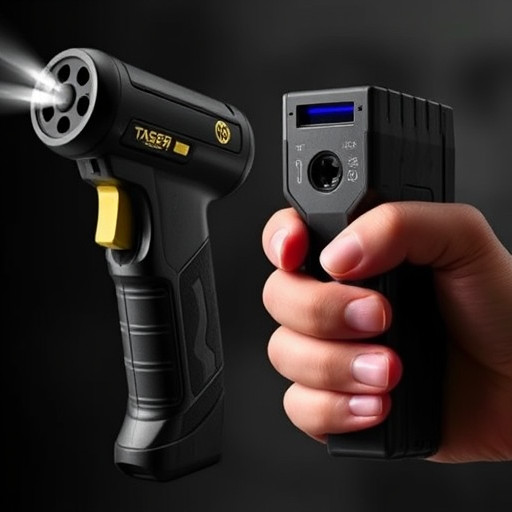Stun guns and tasers offer distinct approaches to self-defense. Stun guns emit a single shock through two probes, temporarily disabling an attacker within 2–3 feet (0.6–0.9 meters), while tasers use electric arcs to fire multiple probes from up to 35 feet (10.7 meters), causing muscle disruption and temporary paralysis. Stun guns are easier to use one-handed without contact, ideal for close quarters; tasers provide a safer distance of engagement. The choice between them depends on individual needs, with tasers favored for range and accuracy. Both must be used legally and safely, adhering to local regulations and training in their unique operation.
“In today’s world, women’s self-defense options are more crucial than ever. Understanding the difference between stun guns and tasers is vital for making an informed choice. This comprehensive guide delves into the unique features and functionalities of each tool, highlighting their advantages and disadvantages. We explore how stun guns work, the specific benefits of tasers, and key differences in power output, range, and safety considerations. By considering these factors, women can empower themselves with the best self-defense solution tailored to their needs.”
Understanding Stun Guns: How They Work and Their Advantages
Stun guns, also known as electroshock weapons, utilize electrical current to disrupt muscle control in an assailant, causing them to temporarily lose balance and strength. When activated, the device fires two small probes connected to wires that deliver a high-voltage, low-current shock, typically disabling the target for several minutes. This non-lethal force is particularly advantageous for self-defense scenarios where the primary goal is to incapacitate an attacker without causing severe harm.
Unlike tasers, which use electric arcs to fire probes and are known for their distinctive “tasing” effect, stun guns emit a single, focused shock. Stun guns are generally easier to use, requiring just one hand, and don’t require the user to make contact with the assailant in order to deploy the shock. This difference in operation translates to potential advantages in situations where speed and ease of use are crucial, especially for women looking to protect themselves in threatening environments.
Exploring Tasers: Features, Functionality, and Unique Benefits
Tasers have gained popularity as powerful tools for self-defense, offering a unique approach to deterring potential attackers. Unlike traditional stun guns, Tasers use electroshock technology to incapacitate an assailant. Each device fires two small probes connected to wires, delivering a strong electrical pulse that disrupts muscle control in the target area, typically causing temporary paralysis. This innovative design provides several advantages for women considering self-defense options.
One of the key differences between Tasers and stun guns is their range and effectiveness. Tasers have a more extended reach, allowing users to disable attackers from a safer distance. Their probes ensure accurate contact, making them reliable for self-defense scenarios. Moreover, Tasers are known for their quick deployment, providing an immediate response in high-stress situations. This technology offers women a strategic advantage, giving them the confidence to defend themselves effectively while minimizing physical harm to both parties.
Key Differences: Power Output, Range, and Safety Considerations
When comparing a Taser and a stun gun for self-defense, understanding their key differences is essential for making an informed choice. One of the most significant distinctions lies in their power output. Tasers are known for delivering powerful electrical pulses that disrupt muscular control, causing the target to stumble or fall. In contrast, stun guns emit a high-voltage, low-current electric discharge, which temporarily incapacitates the opponent by overloading their nervous system.
In terms of range, Tasers generally have a longer reach, allowing users to disable targets from a farther distance. Stun guns, on the other hand, require closer proximity for effective use. Safety is another critical factor; Tasers have a safety probe that must make contact with the target’s body, while stun guns can be activated without direct contact, offering some advantage in certain situations. However, both weapons should be handled with care to ensure user safety and minimize the risk of injury to oneself or others.
Women's Self-Defense Needs: Evaluating Which Tool Fits Best
Women’s self-defense needs vary greatly depending on individual circumstances, but one universal requirement is a tool that provides effective protection with minimal risk. When considering options like stun guns and tasers, understanding the difference between them becomes crucial.
Stun guns emit a powerful electric shock designed to temporarily incapacitate an attacker, giving the user precious time to escape. On the other hand, tasers fire probes that deliver a targeted electric pulse, disrupting muscle control and causing temporary paralysis. While both devices serve as effective self-defense mechanisms, their operational differences and intended uses should guide women’s choices based on their specific needs, such as range, power, and ease of use.
Legal Aspects and Personal Safety Training: An Integral Part of Ownership
The legal landscape surrounding self-defense tools like stun guns and tasers varies by jurisdiction, making it crucial for any prospective owner to understand their region’s regulations. Both stun guns and tasers are categorized as less-lethal weapons, but they differ significantly in design and functionality. While stun guns deliver a high-voltage electric shock through contact, tasers use a probe to shoot two small darts that also deliver an electric pulse, temporarily incapacitating the target. Understanding these differences is essential for adhering to legal boundaries, as excessive or inappropriate use can lead to legal repercussions.
Personal safety training should accompany any decision to own and carry such devices. Learning proper usage, safety protocols, and de-escalation techniques ensures that individuals can effectively protect themselves while minimizing risks. This training goes beyond merely understanding how the device works; it equips users with the knowledge to make informed decisions in high-stress situations, promoting their personal safety without unnecessarily endangering others or inviting legal trouble.
